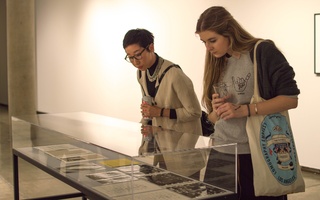“Common Threads: Weaving Stories Across Time,” which runs through Jan. 13 at the Isabella Stewart Gardner Museum, features a diverse collection of textile-inspired artworks of different mediums, created by contemporary artists from around the world. The exhibit strives to “explore the ways in which the art of the past continues to inspire artists now” and executes this goal perfectly. Each piece is distinctive from the others, and ties together both old and new elements of textile art in a novel way.
The exhibit is split into two components: the Cyrus Tapestries, a set of five 16th century tapestries depicting the rise and fall of Cyrus the Great, and the collection of various contemporary pieces in the Hostetter Gallery on the second floor. Though the museum has been in possession of the Cyrus Tapestries for awhile, composer David Lang’s new opera “true pearl: an opera in five tapestries” puts a contemporary twist on the exhibit. The minimalist-style opera features five tracks corresponding to the five main tapestries in the collection, which visitors listen to through provided headsets as they view each tapestry at their own pace. Strange, repetitive lyrics sung by a chorus of voices describe the scene depicted on the corresponding tapestry. For the tapestry in which a secret messenger from Harpagos, the king’s general, delivers a note concealed inside the body of a dead rabbit to Cyrus, the voices sing “We’ll never forget this rabbit. Hare of the steppes / The papers in its gut, concealed.” The opera offers an unusual but refreshingly inventive complement to the exhibit, allowing the visitor to experience art across time periods and mediums through visual and auditory stimulation. The ambient and experimental feel of the music enable the visitor to view the historical tapestries from a new perspective, effectively fitting the theme of connecting “stories across time.”
The other part of the exhibit features a variety of works which integrate different materials, methods, and mediums. Pieces in this collection are created by artists from around the world. “The Great Bare Mat” by the Raqs Media Collective is a carpet inspired by a pun, which comes from two Chinese Han Dynasty bronze mat-weights shaped like bears. One remarkable feature of this carpet, tying together the past and the present, is the seemingly random pattern of white lines spanning across the carpet — the pattern was actually generated by a computer algorithm belonging to members of the Raqs Media Collective. Examples of other works in the exhibit include Lee Mingwei’s “The Mending Project,” a dynamic and interactive piece which invites visitors to bring a broken item to be repaired by a volunteer, intended to spark conversation and “small moments of connection and repair,” according to a description at the exhibit, and Nevet Yitzhak’s “Warcraft,” a digital animated projection of Afghan prayer rugs depicting the mechanical destruction of war, complete with explosive sound effects. Although every work in the room is unique and vastly distinct from any other piece, they are all connected by the same theme of integrating the old and the new to tell powerful stories of the human experience across time.
Even for non-contemporary art enthusiasts, this exhibit is a must-see. Though the exhibit itself is not large, it leaves a powerful impression on the viewer that will last well beyond the walls of the museum. “Common Threads: Weaving Stories Across Time” truly lives up to its name, beautifully demonstrating how art can break barriers and connect people across time and across cultures.
Read more in Arts
Portrait of an Artist: Meredith Hodges ’03Recommended Articles
-
Contented Cows Grazing in the Yard, and Early College Buildings Shown in Widener ExhibitionDays when cattle browsed in the Harvard Yard and when a total of twelve houses and four barns fronted on
-
Harvard Camera Club.The Harvard Camera Club has decided to postpone its fall exhibit till January 9, 10 and 11. This will give
-
No HeadlineThe one society which is, perhaps, unique with Harvard, is the Photographical Society. The society is one of the most
-
 Carpenter Center Opens Two New Exhibits
Carpenter Center Opens Two New Exhibits -
‘Common Threads: Weaving Stories Across Time’ Holds True to Its NameEven for non-contemporary art enthusiasts, this exhibit is a must-see. Though the exhibit itself is not large, it leaves a powerful impression on the viewer that will last well beyond the walls of the museum. “Common Threads: Weaving Stories Across Time” truly lives up to its name, beautifully demonstrating how art can break barriers and connect people across time and across cultures.













